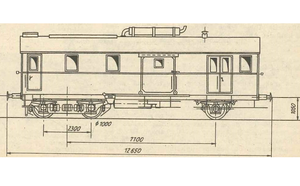NhE T 03
| NhE T 03 | |
|---|---|
|
last operating status
|
|
| Numbering: |
NhE T 03 DR VT 135 552 |
| Number: | 1 |
| Manufacturer: | Railway depot Haldensleben Haldensleben |
| Year of construction (s): | 1932 |
| Retirement: | 1965 |
| Type : | 1Bo 'de |
| Genre : | Pw3vT |
| Gauge : | 1435 mm ( standard gauge ) |
| Length over buffers: | 12,650 mm |
| Height: | 3,650 mm |
| Width: | 2,650 mm |
| Trunnion Distance: | 7,100 mm |
| Bogie axle base: | 2,300 mm |
| Total wheelbase: | 8,250 mm |
| Service mass: | 31,300 kg |
| Top speed: | 60 km / h |
| Installed capacity: | 235 kW (320 hp) |
| Wheel diameter: | 1,000 mm |
| Motor type: | MWM Mannheim RS 125 S. |
| Motor type: | Six-cylinder four-stroke diesel engine |
| Rated speed: | 1,100 rpm |
| Power transmission: | electrical system GEBUS |
| Brake: | Compressed air brake type Knorr |
The NhE T 03 railcar was a railcar of the Neuhaldensleben Railway Company . The railcar was built in 1932 by the Haldensleben depot and used as a passenger train in conjunction with two control cars. The railcar acted as a baggage and mail car. The vehicle was retired in 1965.
history
As a result of the global economic crisis , the Neuhaldensleben railway company was forced to rationalize its operations. After a two-axle passenger car was converted into a diesel-electric railcar in the Haldensleben depot in 1930, a railcar was to be built for the Neuhaldensleben railway company . A conventional van was chosen as the donor vehicle for the vehicle. The vehicle was to be used in combination with two control cars as a tow car with a luggage compartment. A powerful diesel engine was planned for this configuration; in connection with the heavy electrical equipment of the machine system, one axle of the vehicle was exchanged for a bogie of Prussian standard design, in which both axles were driven by a 95 kW electric motor. The diesel engine was above the bogie.
For each of the two control cars, a two-axle passenger car was converted into a control car and designated as C 509 and 510. The drive system of the train was controlled by a simple multiple control from the leading control car. In May 1932, the tow car with its two control cars was approved by the Reich authorized representative of the private railway supervision. The vehicle then made up the majority of passenger traffic on the Haldensleben – Eilsleben railway line. The daily mileage was given as 250 kilometers. In keeping with the spirit of the times, the vehicle, with which travel times significantly decreased, was popularly known as the Fliegender Eilslebener . Thanks to the sufficiently high motorization, the railcar was able to carry 100 t as an additional load at 40 km / h on a gradient of 15 ‰. For an even higher transport capacity, the company commissioned a four-axle control car for the tow car in 1937, which was designated as the 511. The two-axle C 510 had to be handed in during the war and did not return. The other vehicles were designated as VT 135 552 , VS 144 501 (C 509) and VS 144 502 (C 511) by the Deutsche Reichsbahn in 1950 and adopted for operation. The VT 135 552 retired a few years later due to the defective engine system and was soon taken out of service, while the two control cars continued to be used as passenger cars. The VS 144 502 was renamed 197 833 without a driver's cab in 1970. In 1985 it was taken over by the Salzwedel group of the DMV and processed. Today it is in the historic Wittenberge engine shed .
Photos and a model of the railcar are available.
Constructive features
The drive motor was located above the bogie of the railcar. From him the exhaust gases were discharged into the open through an exhaust pipe on the roof. This gave the railcar its characteristic appearance. The main generator, which was manufactured by Siemens-Schuckertwerke , was connected directly to the engine . The drive motors also come from SSW and were designed as a pawl bearing drive . They were controlled with the simple electrical transmission according to the GEBUS system . The auxiliaries such as the cooling fan and the compressor were driven by DC machines.
The brake consisted of a Knorr type compressed air brake and a handbrake. Other auxiliary operations of the T 03 included a pneumatic sand spreader, a bell and a typhon.
literature
- Dirk Endisch: Small and private railways in the Ohrekreis , Verlag Dirk Endisch, Korntal-Münchingen 2007, ISBN 978-3-936893-12-0
Web links
Individual evidence
- ↑ Dirk Endisch: Klein- und Privatbahnen im Ohrekreis , Verlag Dirk Endisch, Korntal-Münchingen 2007, ISBN 978-3-936893-12-0 , page 56
- ↑ a b c d Dirk Endisch: Klein- und Privatbahnen im Ohrekreis , Verlag Dirk Endisch, Korntal-Münchingen 2007, ISBN 978-3-936893-12-0 , page 57
- ↑ Dirk Endisch: Small and private railways in the Ohrekreis , Verlag Dirk Endisch, Korntal-Münchingen 2007, ISBN 978-3-936893-12-0 , page 59
- ^ Website Dampflokfreunde Salzwedel, accessed on May 4, 2016
- ↑ Photo of the vehicle as a model
- ↑ Photo of the T 03 as a model
